Posted by Elena del Valle on September 2, 2016
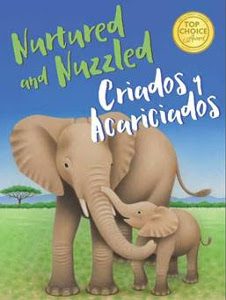
Nurtured and Nuzzled
Photos: Platypus Media
Washington, D.C. company Platypus Media recently published Nurtured and Nuzzled, Criados y Acariciados (Platypus Media, $9.95), a bilingual booklet for children up to five years of age featuring pretty color illustrations by Mike Speiser. The project required thirty months from concept to review copy publication. The biggest challenge it faced was the translation.
When asked what prompted her to publish Nurtured and Nuzzled Dia Michels, publisher, Platypus Media, said, “Books are like food; they nourish us. Our work, as book publishers, is to excite kids about reading and to give adults the tools they need to keep kids engaged in books. Research shows that kids who love reading are more successful in life. And the latest research on the Word Gap, tells us that brain development is dependent on exposure to words and interactions with adults. We were not looking to publish an early childhood book when Mike Speiser’s art landed in our mailbox, but once we saw it, we knew it needed to be put into the world. Books have the power to change lives and, we hope that, in a small way, we can be a part of that process.”
“I chose species that people could relate to,” Speiser replied by email when asked how he selected the animals for inclusion. “There are so many animals to choose from, but they have different levels of appeal. Some of them you can’t possibly use. You don’t get a warm feeling when you look at, say, armadillos. A locust has a fascinating life, but no one wants to know about locusts. There are plenty of other species that are appealing, so I picked those. Elephants, penguins and flamingos have universal appeal. I want to do something for the planet. Connecting with people is my way of doing that. Almost everything we care about stems from our childhood experiences. I was lucky. When I was young, I had parents who were very attentive. We always had a cat and she had several litters of kittens. Being a witness to birth had a huge impact on me. I have been drawn to capture the magnificence of animals ever since. Picking animals that have broad appeal encourages readers of the book to help life. It is my way of celebrating life. “I want to reach children at that special age because that’s when their brains are developing really quickly. If I can get them to love animals when they are young, I can make a different in that child.”
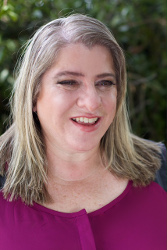
Dia Michels of Platypus Media
“Originally the book was all about the artwork and the messaging,” Michels said when asked why she decided on a bilingual book. “In the winter of 2015, I was speaking at the National Fathers and Families Coalition of America conference in Los Angeles. I had a prototype of the book with me. A number of the attendees suggested it would be a more powerful book if it were bilingual. They stressed that adding Spanish would allow us to reach more kids, and, more importantly, kids who could really benefit from a book like this. I listened, and, as soon as I returned to the office, we started redesigning the book to add the second language.”
After researching bilingual education (she referred to sciencenaturally.com/files/BilingualEd.pdf) she became convinced that there were more Spanish speakers in the U.S. than there are in Spain; “that nearly 25 percent of all K-12 students in the U.S. are Latino—and the percentage is growing.” She went on to say that the numbers were compelling.
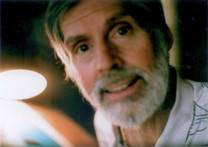
Mike Speiser, illustrator, Nurtured and Nuzzled
“Nurtured and Nuzzled, Criados y Acariciados was our first bilingual book,” said Michels when asked about similar projects in the future. “Once we made the commitment to make it bilingual, we wanted to carry that commitment to our other projects. Our sister company, Science, Naturally, produces math and science books for upper elementary and middle school. We are incredibly excited about the release of our first bilingual book for this list, One Minute Mysteries: More Short Mysteries You Solve With Science! Misterios de un minuto: ¡Más misterios cortos que resuelves con ciencias! It is the bilingual edition of our best-selling One Minute Mystery books. We are now working on the bilingual edition of our bestselling math book: One Minute Mysteries: Short Mysteries You Solve with Math!, Misterios de un minuto: ¡Misterios que resuelves con matemática! will be released in April 2017. We will carry this commitment forward and work to create bilingual products for the foreseeable future. We hope to do another early childhood book with Mike Speiser exploring different habitats, but it is still on the drawing board.”
The work of Speiser, an artist who lives next to the Black Hills of South Dakota, has been featured on the covers of Wild Animal Baby magazine and on fundraising products for science organizations. His paintings have been displayed at the Leigh Yawkey Woodson Art Museum. He is involved with efforts to protect the natural world for future generations. He sent his wok to Platypus Media after seeing If My Mom Were A Platypus at his local library.

Click to buy Nurtured and Nuzzled – Criados y Acariciados
Comments:
Filed Under: Books
Posted by Elena del Valle on August 5, 2016
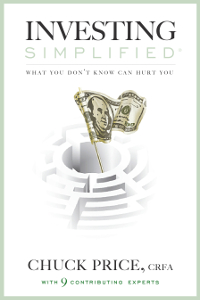
Investing Simplified
Photos: Chuck Price
After 40 years in the financial advice business Chuck Price, CRFA was convinced he could provide information for his clients and prospective clients better than the many books already published on the subject. Toward that goal he teamed up with nine colleagues to publish Investing Simplified (Advantage Media Group, $19.99) in 2014. They dedicated four years from idea to publication to make it happen.
“To me most Financial Books seemed very complicated and my clients told me I simplified concepts for them, so Investing Simplified became our slogan and a book,” Price said by email when asked why he wrote the book. Investing, he said “means to take a risk on your principle expecting returns, but may have losses as well.”
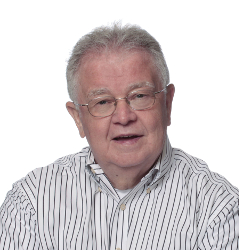
Chuck Price, author, Investing Simplified
The question most frequently asked by his clients is how much income they need to retire. He addresses the issue in Chapter 12. He began by suggesting readers figure out the following about their financial and life situation: current income and expenses, fixed and variable income sources, debt, life plans for retirement, life expectancy and long term care needs.
When asked what were the biggest challenges to writing and publishing his book he said, “Time, there are only so many hours in a day would be 1st. but second is writing does not come easy and anyone that thinks you can just set down and put your thoughts on paper and have it make sense is fooling themselves. Anyone that thinks it’s easy should try it.”
The 337-page softcover book is divided into 15 chapters and nine appendices. The final 100 pages make up the appendices written by the contributors. Price said he wanted to the book to be used as a training guide for the Average Person. He proposed a concept through which the advisor would work directly with a client’s attorney, accountant, long term care planner, and insurance agent. His next title? Why you need a Financial Doctor, just like you need a Medical Doctor.
Price, president and wealth manager, Price Financial Group Wealth Management, Inc., a Registered Investment Advisor firm in Portland, Oregon, has 40 years of financial experience. He is host of the Investing Simplified radio show that airs live Saturday mornings on Freedom970.
Jerry Murphey, president, FolioMetrix, LLC contributed The Four Principles of Risk-Intelligent Investing; Carl Jepsen, partner, in Warren Allen LLP Law Firm, contributed Estate Planning; Keven Steege, CPA contributed Finding and Hiring a CPA; Mei Wong of Senior Resources Today contributed Hidden VA Benefits; Rick Dimick, Life Insurance Linked/hybrid Benefits & Long term care specialist, contributed Long-Term Care; Mark Eshelman, loan officer, Reverse Mortgage, contributed Reverse Mortgages; Karen Kane contributed Medicare the Big Unknown; Janelle Markovich, sales executive, Propel Insurance, contributed Protecting Your Business; and Michael Dougherty, preplanning advisor, Dignity Memorial contributed Planning Your Funeral.
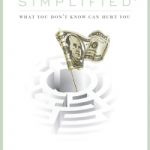
Click to buy Investing Simplified
Comments:
Filed Under: Books
Posted by Elena del Valle on July 22, 2016
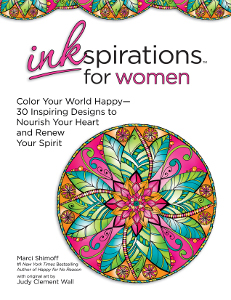
Inkspirations for Women
Photos: Health Communications
Coloring books for adults seem to be popping up everywhere lately. According to one source, in 2015, half the bestsellers on Amazon were adult coloring books (see Science-Backed Reasons To Add Coloring To Your Self-Care Practice by Judy Clement Wall mindbodygreen.com/0-24373/science-backed-reasons-to-add-coloring-to-your-self-care-practice.html). Studies indicate a brief period of art making can reduce anxiety. Some believe coloring makes people better thinkers and helps them to focus effectively.
So when information about a new coloring book arrived in my inbox I decided to take a look. Inkspirations For Women Color Your World Happy – Inspiring Designs to Nourish Your Heart and Renew Your Spirit (Health Communications, Inc. $19.95), the result of a collaboration between Marci Shimoff, author, Happy for No Reason, (see Listen to podcast interview with Marci Shimoff, author, Happy for No Reason about finding happiness) and Judy Clement Wall, a freelance artist, illustrator, and writer, is a softcover publication designed to be completed by coloring aficionado buyers. The project, which features 30 intricate designs of flowers, fauna and meditative mandalas, required four months from conception to publication.
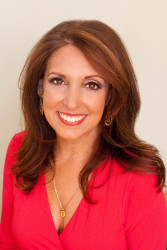
Marci Shimoff
“The idea to do an Inkspirations For Women book came about while I was illustrating HCI Books’ first coloring book, Inkspirations For Recovery, which is a book specifically designed for people using the Twelve-Step principles,” said Clement Wall by email when asked how she had become involved with the project. “We wanted to do another positive, uplifting book designed to inspire and encourage women.”
She and Shimoff, a New York Times Bestselling author, had worked together on other books through their publisher, HCI Books. When asked who might like the book, she said, “I think all women would like it. The illustrations are detailed, but not too complicated – just right for exploring your creativity, unwinding, and focusing inward in a really comfortable, fun way. The quotes and mantras are very inspiring, centered around the subjects of love, hope, dreams, gratitude, and self-belief.”
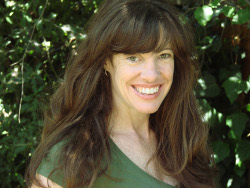
Judy Clement Wall, illustrator, Inkspirations for Women
The biggest challenges to writing, illustrating and publishing the coloring book the illustrator said were, “Learning how to draw for coloring. It’s a different kind of illustration. When I draw with the intention of my art being colored, I absolutely have the colorist in mind. I think of the finished pieces as collaborations. Often people post their colored pages to my Facebook wall, and I love seeing them.”
The book includes inspiring quotes and motivating mantras from Shimoff on love, hope, gratitude, and dreaming big. It also has an artist how-to section on customizing the art, thick stock paper compatible with colored pencils, markers, or watercolors, and perforated pages to encourage framing or sharing finished pieces.
Clement Wall is working on two more coloring books for HCI and a book of colorable postcards, to be released later this year. Shimoff is also author of Love for No Reason, co-authored six titles in the Chicken Soup for the Woman’s Soul series, and is a featured teacher in The Secret. She did not respond to questions for this note. The publisher is planning several more books in the Inkspirations series by different illustrators.

Click to buy Inkspirations for Women
Posted by Elena del Valle on July 1, 2016
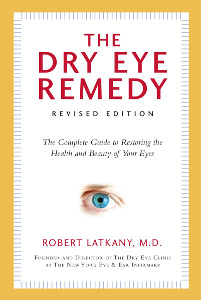
The Dry Eye Remedy
Photos: Hatherleigh Press
Do your eyes often feel tired? At the end of the day are they sore, burning? You may have dry eye. If so you are not alone. Dry eye is “not having enough quantity and/or quality of tears to coat the surface of the eye that can result in symptoms such as blurry vision, dryness, irritation, burning, foreign body sensation, and even pain,” according to Robert Latkany, M.D., founder, The Dry Eye Clinic at The New York Eye & Ear Infirmary.
In The Dry Eye Remedy Revised Edition The Complete Guide to Restoring the Health and Beauty of Your Eyes (Hatherleigh,$15.95) a 218-page soft cover book published in 2016, Latkany discusses the topic. The title, which he developed over a year from idea to publication, is an update to his first book on the same subject published in 2007. His target audience is anyone who suffers from dry eyes, from post menopausal women to the young contact lens wearing crowd.
When asked by email what prompted the release of the revised edition, he replied, “I figured 9 years later an update was needed as there were a lot of advances in diagnostic testing and some advancement in therapeutic options now available that the public needed to know.” To the question in what ways exactly is the new edition different from the original? he said, ”
There is a lot of new information on new diagnostic testing available in the eye doctor’s office. And there are a few new therapies. So these two sections had the most changes.”
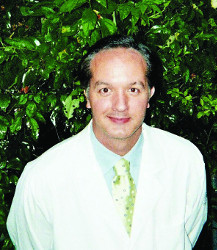
Robert Latkany, author, The Dry Eye Remedy
While inflammation is a major cause of dry eye not all dry eye patients have inflammation, the ophthalmologist explained when asked if dry eye was another term for inflammation. Other causes of the condition include cosmetic surgery, stress, and allergies. On the good news front, it is possible to remedy dry eye with nutrition and lifestyle changes alone.
“What you eat and what you are around and the daily stresses of life can have a major impact on dry eyes,” said Latkany, who is considering writing a book about ocular rosacea and allergies in the eyes.
When asked about the rewards to writing the books he said, “I have performed many different eye surgeries, including cornea transplants, cataracts and laser eye surgery and to improve vision on someone is very rewarding. But to make a neglected debilitated dry eye patient happy and feel more comfortable is extremely rewarding. They are very grateful.”
Dry eye, which can range from mild discomfort to serious, affects tens of millions of Americans and has no cure. Among sufferers more women than men (two to one, according to the National Eye Institute) are afflicted by dry eye, Latkany points out in the book.
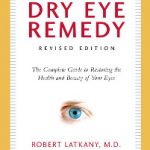
Click to buy The Dry Eye Remedy, Revised Edition
Comments:
Filed Under: Books
Posted by Elena del Valle on June 24, 2016
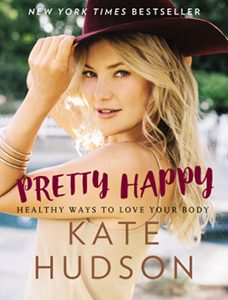
Pretty Happy
Photo: HarperCollins Publishers
Based on her personal experience Kate Hudson, actor and producer, believes the path to good health requires discipline and involves listening to her body and her mind, feeling good in her body and connected with it by slowing down, eating well, exercising and meditating. Making lifestyle changes takes time and effort, she says. To reach her goal she follows four guidelines she calls pillars: Cultivating an intuitive relationship with her body; eating well; awakening her body; and the miracle of mindfulness.
In Pretty Happy: Healthy Ways to Love Your Body (Dey Street Books, $26.99), a 235-page hardcover book published February 2016, she and Billie Fitzpatrick explain her approach to life. It includes questionnaires for readers and is divided into ten chapters and three main areas: Becoming Body Smart, The Four Pillars in Practice, and Living Body Smart. In the book, peppered with color photos of Hudson, thin, with blond highlights and make up, she says she believes in self acceptance.
In her personal journey toward healthy living she relied on a variety of sources, she explains at the beginning. At the end of the book she shared a short list of books for readers who want to know more. She believes in Ayurvedic eating with an emphasis on whole alkaline (as opposed to acidic) foods. In the book, she shares a sample list of acidic and alkaline foods. She is convinced that enjoying what she does when she exercises is important. Although moving is essential, there is no single answer that applies all the time or to everyone, and each person has to dedicate time to understanding her or his body, Hudson says.
Fitzpatrick has collaborated on nonfiction books about mind-body health, nutrition, fitness, neuroscience, business and sexuality. Hudson is cofounder of Fabletics. She was unavailable to respond to questions, according to a representative from her publishing company.
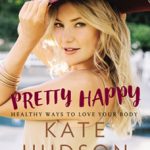
Click to buy Pretty Happy
Comments:
Filed Under: Books
Posted by Elena del Valle on June 10, 2016
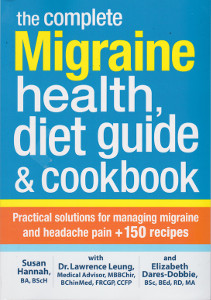
The Complete Migraine Health, Diet Guide and Cookbook
Photos: Robert Rose
When it comes to migraines science is still in the dark in many respects. Elizabeth Dares-Dobbie BSc, Lawrence Leung, MBBChir, and Susan Hannah believe migraine headaches are caused by histamines. They are convinced that lifestyle and understanding the triggers that cause migraines can lead to managing the chronic condition in order to prevent them, reduce their frequency or deal with them after they occur.
In The Complete Migraine Health, Diet Guide and Cookbook (Robert Rose, $24.95), the three share their ideas on the topic along with 150 recipes designed to minimize foods likely to trigger migraines. The 336-page book, published in 2013, was the first book for all three and required 15 months from idea to publication. It is divided into three main parts: Understanding Migraine, Cluster and Tension Headaches; Managing Primary Headaches; and Low-Histamine Diet Program.
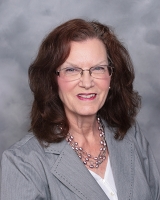
Elizabeth Dares-Dobbie
When asked by email via their publisher how their book stands out among the many titles on the subject Dares-Dobbie and Hannah replied: “Our Migraine book offers a complete package for the reader. Starting with a description of the symptoms and physiology of the 3 different headache types: migraine, tension, and cluster, moving on to the current guidelines health professionals follow when providing care for headaches. Next, we provide an in-depth description of the various drugs given for each scenario, the options for therapies provided both by traditional Western medicine or alternative medicine and end that section with lifestyle tips to reduce the impact of headaches. We describe the theory of how high histamines may cause headaches for some people, explaining exactly what happens in our bodies, and go on to provide a low histamine diet meal plan, followed by 150 recipes that work with the meal plan. Through the recipe section, we give tips on how to reduce histamines in family favourite recipes, such as serving hot sauces at the table rather than including them in a dish (for people whose histamine levels rise to cause a headache from hot sauce). Our book is easy to read and well organized.”
They set out to share with readers ways to identify the signs and symptoms for migraines, cluster, and tension headaches; learn about headache triggers; understand diagnosing tests; learn about treatments traditionally used by physicians and other healthcare providers, including the use of prescription medications, physiotherapy, and surgery; consider the benefits and risks of alternative treatments, such as acupuncture, body-mind medicine, and medicinal herbs; understand the role of nutrition and diet in the management of headaches; and adopt a healthy meal plan that focuses on enjoying antihistamine headache foods and eliminating foods that increase the risk of headache.
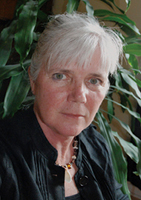
Susan Hannah
When asked why they believe there is a link between histamines and migraines, Dores-Dobbie and Hannah replied, “Long-standing research has shown a link between histamines and migraines. For decades, people with migraines have been warned away from foods high in histamines, such as red wine, old cheese, chocolate, and more. We relied on recent research to identify foods with different levels of histamine, including foods that have no histamine, and foods that help to reduce histamine, such as fresh and dried herbs added to recipes.”
Dares-Dobbie is a registered dietitian and nutrition consultant with expertise in diabetes, hypertension, cholesterol management, geriatric nutrition, gastroenterology, and food allergies. She runs a nutrition consulting business and practices in long term care in Kingston, Ontario.
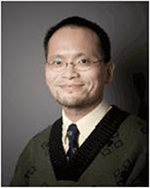
Lawrence Leung
Hannah is a freelance writer, book designer, photographer and former research associate at the Department of Family Medicine at Queen’s University in Kingston, Ontario. She is keenly interested in lifestyle choices and diet as possible therapeutic strategies for improving health conditions and quality of life. Leung, associate professor in the Department of Family Medicine at Queen’s University, is a published medical research scientist and practicing physician of Western and traditional Chinese medicine.
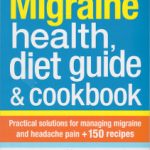
Click to buy The Complete Migraine Health, Diet Guide and Cookbook
Comments:
Filed Under: Books
Posted by Elena del Valle on May 27, 2016
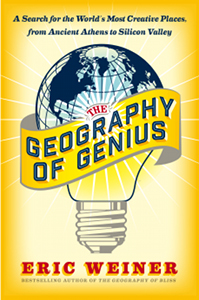
Geography of Genius
Photos: Simon & Schuster, Justin Tsucalas
Travel enthusiast and journalist Eric Weiner has become convinced there are clusters of geniuses around the world. The connection between our surroundings and our most innovative ideas, according to him, is notable in the present day and throughout history. In The Geography of Genius (Simon and Schuster, $26.95), a hardcover book published this year he explains what he has discovered during his travels. The book required four years of effort from idea to publication.
But, who is a genius? Weiner defines the term, “A genius is not simply someone with a high IQ, a know-it-all. A genius is a see-it-all. That is, someone who makes a conceptual leap and, in doing so, produces something useful or beautiful.”
When asked by email who might want to read his book he said, “Anyone interested in creativity and innovation. Or history, for that matter. Or just a good read. I pride myself on taking complex subjects, like genius, and simplifying them without over simplifying them.”
As to w hy he believes creativity begins at home, the author said,
“If creative genius is a function of place, as I argue it is, then there is no more important place than home. It is where we learn how to interact with the world. As parents, this is a big responsibility. Our children learn more about creativity by simply being a part of a family than they do from all of the ‘creativity exercises’ combined.”
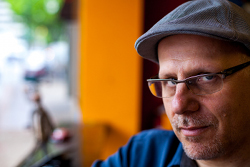
Eric Weiner, author, The Geography of Genius
As to what he means when he says creativity is a relationship that unfolds at the intersection of person and place, he said,
”
We tend to think of creativity as taking place in isolation. The myth of the lone genius is the best example of this, but it is just that, a myth, Creativity always takes place within a certain context. (and a certain time.) Freud’s radical theories about the human mind, for instance, could only have taken place in Vienna of 1900. The place, and time, were ripe for his ideas. Without this ripeness, even the most brilliant idea will die on the vine.”
For those who want to foster geniuses what are the essential elements?
Weiner believes t
hey are: Diversity, Discernment and Disorder.
“Places that are diverse–not only ethnically but also intellectually–are the most creative,” the author said. “They are like a rich and flourishing rain forest, as opposed to a desert. We need tolerance but we also need discernment. Not all ideas are good ones. Creative people don’t get attached to the bad ones. They are willing to ‘kill their darlings’ and move on. A certain degree of disorder, of chaos, even, is essential for a creative place and a creative person. Chaos is the bridge between old orders and new ones. Innovative people embrace it.”
The biggest challenge to writing the book was finding the right balance, between depth and accessibility, humor and seriousness, personal observations and universal truths, he explained.
“The greatest reward is when I receive an email from an appreciative reader who tells me that my book changed her life, in some way, large or small,” he said when asked what was the greatest reward to writing his book. “Ideally, I managed to get her to think about a familiar topic in a a fresh way, That’s what it’s all about.”
Weiner writes a regular column for BBC Travel. Prior to this book he wrote three books including, The Geography of Bliss, a The New York Times bestseller translated into 20 languages. Weiner is the recipient of the Borders Original Voices Award, and a finalist for the Barnes & Noble Discover Award. As a long-time foreign correspondent for National Public Radio, he reported from more than 30 nations, from Iraq to Indonesia, covering some of the major international events of recent times. His next book, still untitled, will be about practical philosophy.
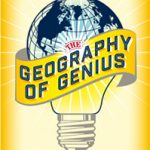
Click to buy The Geography of Genius
Comments:
Filed Under: Books
Posted by Elena del Valle on May 6, 2016
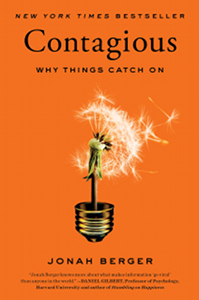
Contagious
Photos: Simon & Schuster, Deborah Feingold
Jonah Berger, Ph.D., who teaches marketing at the Wharton School at the University of Pennsylvania, is convinced popular topics share identifiable commonalities. After spending 15 years studying and researching how social influence works and how it drives products and ideas to catch on he thinks he has uncovered some of the reasons that people talk more about some products and ideas than others. In Contagious Why Things Catch On (Simon & Schuster, $14.69), a New York Times bestseller title published in 2013 and named Best Marketing Book of 2014 by the American Marketing Association, he outlines his theories on the topic.
He says that while people don’t pay attention to advertisements, they listen to their peers. In his book, which took more than 10 years from idea to publication, he outlines six basic principles he is convinced drive things to become popular. He describes them as Social Currency, Triggers, Emotion, Public, Practical Value, and Stories.
Following an introductory chapter, he dedicates a chapter to each of the principles in his 244-page hardcover book. He cites examples of how a steakhouse executive got buzz for his restaurant by adding a luxury sandwich to his menu, why anti-drug commercials may have increased drug use, and why 200 million consumers shared a video about a blender.
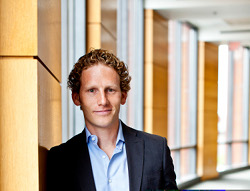
Johan Berger, author, Contagious
He wrote the book for “anyone who wants to get something to catch on. Might be a small business owner with a new service, a marketing manager launching a new product, or someone who wants to get others to change their behavior.”
When asked by email how he defines contagious for marketing purposes the marketing professor said it is “something that spreads from person to person via word of mouth.”
He shares surprising tidbits. For example, in the Leverage Game Mechanics section, he discusses how less than 10 percent of the estimated 10 trillion frequent flyer miles remain unused. In the Make People Feel Like Insiders section, he talks about the new found popularity of the McDonald’s McRib, which despite its name is made mostly of tripe, heart and stomach meat.
His second book, Invisible Influence: The Hidden Forces that Shape Behavior, on a similar topic is due out June 2016. One of the biggest challenges to writing and publishing the book, he said, was pulling all the research together.
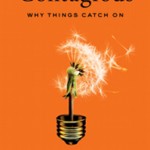
Click to buy Contagious
Comments:
Filed Under: Books
Posted by Elena del Valle on April 29, 2016
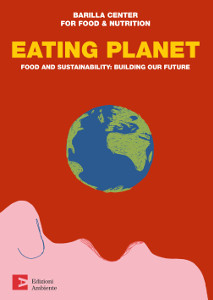
Eating Planet
Photos: Barilla Center for Food and Nutrition
Obesity costs the global economy $2 trillion annually. Contrasting that food waste costs another $2.6 trillion globally, according to the U.N. Food and Agriculture Organization (FAO). To put the issue of food into a human perspective 795 million people are believed to suffer from hunger or famine while at the same time 2.1 billion people are obese or overweight, according to the Barilla Center for Food & Nutrition Foundation in Italy. The organization and its members are among the high level thinkers across the globe concerned about the issues of food and nutrition.
In late February 2016, the Foundation launched the new edition of Eating Planet: Food and Sustainability: Building Our Future designed to provide “a comprehensive tool summarizing business perspectives on the global problems of food sustainability.” The first edition was published in 2012.
“These proposals can now be used as a starting point to truly correct the imbalances and distortions that are affecting the planet and the life of every one of us,” said Paulo Barilla, vice president, Barilla, in a promotional email about the book.
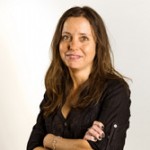
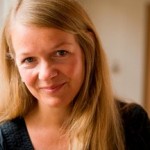
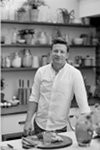

Contributing authors (left to right) Danielle Nierenberg, Barbara Buchner Matt Russell and Paolo De Castro
The report, to be published in several languages, focuses on the need for decision-making tools to guide research and innovation in the sector. The various authors suggest priority initiatives for decision makers and citizens, including many initiatives that have already been established by BCFN’s other action platforms such as the Milan Protocol and the Youth Manifesto.
The 301-page English language edition is divided into four main sections: Food For All, Food for Sustainable Growth, Food for Health, and Food for Culture. It is peppered with colorful photos and graphics.
Among the numerous contributing authors are Barbara Buchner, head of Climate Policy Initiative in Europe; Paolo De Castro, Italian politician, economist and agronomist; Carlo Petrini, president, Slow Food; Ricardo Uauy, professor, Public Health Nutrition at the Institute of Nutrition and Food Technology; Shimon Peres, President of Israel from 2007 to 2014; and Danielle Nierenberg, president, Food Tank.
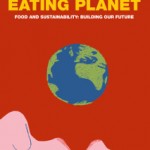
Click to buy Eating Planet – english edition
Comments:
Filed Under: Books
Posted by Elena del Valle on April 15, 2016
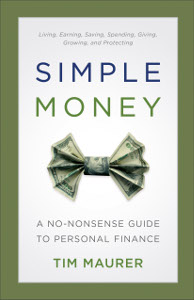
Simple Money
Photos: PR by the Book
Tim Maurer, director of personal finance, at Buckingham and the BAM Alliance, helps a team of 350 financial advisors nationally focus on the personal, non-numerical elements of financial advisory work such as behavioral finance, client interaction and communication. He dedicated a little over a year from idea to publication to Simple Money A No-Nonsense Guide to Personal Finance (BakerBooks, $15.99), a 285-page softcover book published this year, hoping, he says in the first chapter, for readers to find contentment, a richer life and a freer mind through the book.
When asked by email via his publisher how he defines simple money, he said: “Money management is complex because we are complex. Therefore, it is in better understanding ourselves that we are able to make even the most confounding financial decisions simple.”
The book is divided into 21 chapters and five parts: Planning for Life, Planning for Today, Planning for the Inevitable, Planning for the Unexpected and Planning for Action. He wrote the first two parts of the book, Planning for Life and Planning for Today, for all readers. The remainder he wrote for those curious about a particular topic like investing, life insurance, retirement planning or estate planning. He starts outlining four basic concepts: Personal finance is more personal than it is finance; We need to know why; Simple not simplistic; and Enough is “enough.”
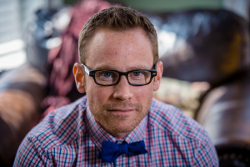
Tim Maurer, author, Simple Money
“For many years, I’ve said that ‘personal finance is more personal than it is finance,’ a statement that resonates anecdotally with most,” he said when asked why he wrote the book. “But my research more recently, especially in the field of behavioral finance and the science of motivation, has proven the statement to be scientific fact. This inspired me to synthesize the best of behavioral finance and use it as a lens through which to reexamine personal finance. The challenge, of course, was in making it ‘simple’ enough to be practical. But that’s always been my passion.”
The biggest challenge he faced writing the book was that, “Although it’s not the first time I’ve shared it, I give the most detailed rendition to date of the story of my near-death car accident that forever shaped my view of life, work and money,” he said. “It’s an important story, and it’s good for me to tell it, but it’s not necessarily easy.”
Each chapter begins with an explanation of what makes the topic relevant to the reader and ends with summary points. In the book, he says that “One of the ways we can make financial decisions simple is to genuinely understand what motivates us.” He goes on to say that although motivation is at the root of what we want too often it remains separate from our financial planning.
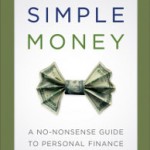
Click to buy Simple Money
Comments:
Filed Under: Books














































